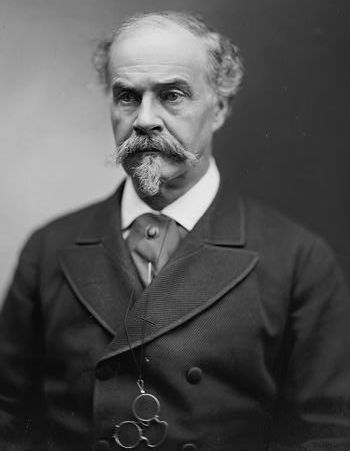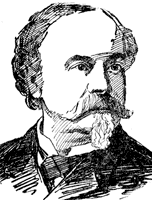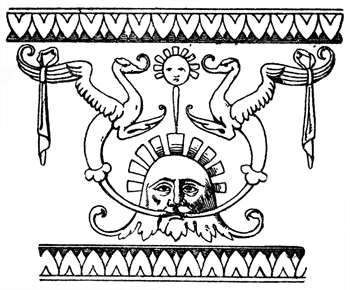|
William Wetmore Story
Library of Congress "MR. STORY was born in Salem, Mass., February 19, 1819, and was son of Justice Joseph [Story] and Sarah Waldo (Wetmore) Story. He entered Harvard College, from which he graduated in 1838, at the age of nineteen. He pursued a course of legal studies under his father's supervision [attending lectures given by his father at the Harvard Law School], and wrote and published several treatises on law subjects. He also published other volumes of prose, among them being 'Roba di Roma,' published in 1862, 'Graffiti d'Italia,' published in 1869, and an exhaustive life of his father, which was published in two volumes in 1851. He was a frequent and entertaining contributor, in both prose and verse, to the Boston Miscellany. He is a good German scholar, and has made a number of poetical translations from that language. . . . He is also an accomplished musician, and widely known as a sculptor. Among the works of sculpture for which he has become distinguished are busts of Josiah Quincy, James Russell Lowell, and Theodore Parker, and statues of his father and George Peabody. His 'Cleopatra and the Sibyl' and 'Delilah' are much admired. . . ." [Sidney Perley, The Poets of Essex County, Massachusetts 155-156 (Salem, Massachusetts: Sidney Perley, 1889] Story's interest in sculpture was promoted when his father died and he was asked to create a sculpture of his then famous father. He agreed to do so only if the patrons of the sculpture would finance a trip to Italy so he could engage in further studies. Story took up residence in Rome in 1856 with his family and became a major social figure in the city as he acquired friends in arts and literary circles. His home in the Palazzo Barberini became a center for Americans living in Rome. William Wetmore Story Three Lawyer-Poets of the 19th Century Transcendental
Period Poets Painting
& Sculpture: Beginnings William Wetmore Story William Wetmore Story: American Art Masterpieces Across
an Untried Sea: Discovering Lives Hidden
[Chandler B. Beach, The New Student's Reference Work for Teachers Students and Families (Chicago: F. E. Compton and Company, 1909)] Poems [Cleopatra] [Io Victis] [L'Abbate] [Snowdrop] [Black Eyes] [In the Rain] [Praxiteles and Phryne] [A Roman Lawyer in Jerusalem, First Century] [Nature and Art - (1844)] Poetry William Wetmore Story, Nature and Art. A Poem (Boston: C. C. Little and J. Brown, 1844) [online text] __________________, Poems (Boston: Charles C. Little and James Brown, 1847) [online text] (Boston: Little, Brown and Company, 1856) [online text] (London: Chapman and Hall, 1863) [online text] __________________, Graffiti d' Italia: Poems (New York: C. Scribner & Co., 1868)(Edinburgh: W. Blackwood and Sons, 1868)(Edinburgh: Blackwood, 2nd ed., 1875)(reprint: Elibron Classics, 2001) [online text] __________________, A Roman Lawyer in Jerusalem: First Century (Boston: Loring, [Reprinted from Blackwood], 1870)(Boston: Colby and Rich, 1875) [online text]
__________________, He and She: or, A Poet's Portfolio
(Boston & New York: Houghton, Mifflin and Company, 1883) [online text] (12th
ed., 1889) [1894 ed., online
text] [online text]
__________________, Poems (Edinburgh & London: William Blackwood & Sons, 1885) [online text] (Boston, New York: Houghton, Mifflin, 1886)(2 vols.)(7th ed., 1897)(Cambridge: Riverside Press, 1890)(2 vols.) __________________, A Poet's Portfolio. Later Readings (Boston, New York: Houghton, Mifflin and Company, 1894) [online text] Anthologies W.W. Story, "A Roman Lawyer in Jerusalem," in J. Greenbag Croke (ed.), Poems of the Law 34-64 (San Francisco: Sumner Whitney & Co., 1885)(Buffalo, New York: William S. Hein & Co., reprint ed., 1986) William Wetmore Story, "A Roman Lawyer in Jerusalem," in Ina Russelle Warren (ed.), The Lawyer's Alcove: Poems by the Lawyer, for the Lawyer and about the Lawyer 5-20 (New York: Doubleday, Page & Company, 1900)(Buffalo, New York: William S. Hein & Co., Inc., 1990)] Correspondence Gertrude Reese Hudson (ed.), Browning to His American Friends: Letters Between the Brownings, the Storys and James Russell Lowell, 1841-1890 (New York: Barnes and Noble, 1965) Leigh Hunt, Six Letters of Leigh Hunt Adressed [sic] to W. W. Story, 1850 1856 (New York: Macmillan, 1913)(Folcroft: The Folcroft Press, 1969)(reprint of the 1913 edition) Writings William Wetmore Story, Reports of Cases Argued and Determined in the Circuit Court of the United States, for the First Circuit (Boston: C.C. Little and J. Brown, 1842)(3 vols.) __________________, Commentaries on the Law of Agency: As a Branch of Commercial and Maritime Jurisprudence, with Occasional Illustrations From the Civil and Foreign Law (Boston: C.C. Little and J. Brown, 3rd ed., 1846) __________________, A Treatise on the Law of Sales of Personal Property: With Illustrations From the Foreign Law (Boston: C.C. Little and J. Brown, 1847)(2nd ed., 1853)(3rd ed., 1862)(4th ed., by Edmund H. Bennett, 1871) __________________ (ed.), Life and Letters of Joseph Story: Associate Justice of the Supreme Court of the United States, and Dane Professor of Law at Harvard University (Boston: Little, Brown, 1851)(2 vols.) [vol. 2: online text] __________________ (ed.), The Miscellaneous Writings of Joseph Story (Boston: Little, Brown, 1852) __________________, A Treatise on the Law of Contracts Not Under Seal (Boston: C.C. Little and J. Brown, 1844)(2nd ed., 1847 (A Treatise on the Law of Contracts, Boston: Little, Brown, 4th ed., 1856)(2 vols.) [vol. 2: online text] __________________, The American Question (London: George Manwering, 1862) __________________, Roba di Roma (London: Chapman and Hall, 1863)(2 vols.)(Chapman and Hall, 3rd ed., 1864)(London: Chapman & Hall; New York: D. Appleton & Co., 4th ed., 1864)(Chapman & Hall, 5th ed., 1866)(Chapman & Hall, 6th ed., 1871)(Philadelphia: J.B. Lippincott & Co., 7th ed., 187_)(Chapman & Hall, 7th ed., 1876)(Boston, New York: Houghton, Mifflin and Company, 8th ed., 1887)(2 vols.) [vol. 1: online text] __________________, A Treatise on the Law of Sales of Personal Property (Boston: Little, Brown and Co., 4th ed., 1871) [online text] __________________, Nero: An Historical Play (Edinburgh: W. Blackwood and Sons, 1875; New York: Scrigner, Welford, & Armstrong, 1875) [online text] __________________, Stephania: A Tragedy in Five Acts, with a Prologue (Edinburgh: W. Blackwood, 1875)(Edinburgh: Printed by William Blackwood and sons, 1876) __________________, Castle St. Angelo. Being Additional Chapters to "Roba di Roma" (London: Chapman and Hall, 1877) [online text] _________________, Second Thoughts: A Comedy in Three Acts (New York, 1878) _________________, Vallombrosa (Edinburgh & London: W. Blackwood, 1881) [online text] _________________, Fiammetta: A Summer Idyl (Boston: Houghton Mifflin, 1886) __________________, Conversations in a Studio (Boston: Houghton, Mifflin and Company, 5th ed., 1891)(1890)(2 vols.) __________________, Excursions in Art and Letters (New York: Houghton Mifflin Company, 3rd ed., 1893)(1891) Misc. Writings Reports of The United States Commissioners To The Paris Universal Exposition, 1878. Vol. 2: Fine Arts, Education, Wood Carving (Washington, D.C.: Government Printing Office, 1880)("The Fine Arts" section of the report is written by William Wetmore Story) Bibliography Mary Elizabeth Phillips, Reminiscences of William
Wetmore Story, Henry James, William Wetmore Story and His Friends; From Letters, Diaries, and Recollections being incidents and anecdotes chronologically arranged, together with an account of his association with famous people and his principal works in literature and sculpture (Boston: Houghton, Mifflin & Co., 1903)(2 vols.)(New York: Kennedy Galleries, 1969)(2 vols.) Piergiacomo Petrioli, William Wetmore Story. Un Americano al Palio (Siena, Italy: Betti, 2000) Jan Seidler Ramirez, A Critical Reappraisal of the Career of William Wetmore Story (1819-1895): American Sculptor and Man of Letters, Ph.D. thesis, Boston University, 1985 Mary Laurentina Taffee, William Wetmore Story: Cultural Interpreter in the New England Renaissance, M.A. thesis, University of Detroit, 1952 Brooks Van Wyck, The Dream of Arcadia: American Writers and Artists in Italy, 1760-1915 (New York: Dutton, 1958)(chapter devoted to William Wetmore Story) Bibliography: Articles M.H. Hoeflich & Lawrence Jenab, Three Lawyer-Poets of the Nineteenth Century, 8 (3) The Green Bag 249 (2005) [online text] Piergiacomo Petrioli, Arte e poesia a Marciano. Il circolo senese dei Browning, in "Bullettino senese di Storia patria," CVIII, 2001, pp. 297-332. _______________, "Robert Browning and his Sienese Circle," in 24 Studies in Browning and His Circle 78-109 (Fall, 2001) Research Resources Willie Tolliver, Henry James as a Biographer: Self Among Others (London: Routledge, 2000)(New York: Garland Pub., 2000)(including a discussion of Jame's biography of William Wetmore Story) Editor's Note We have learned, in communications with Simonetta
Berbeglia, in Italy, that her Italian translation of Story's Vallombrosa
which was originally published by Blackwood & Sons, in Edinburgh,
in 1881 was published by Clinamen, in Florence, in 2002. The Berbeglia
text consists of the original English text, its Italian translation, and extensive notes.
Story goes on to say: "But of the many who know by heart these magical lines, how few there are to whom Vallombrosa is more than a sounding name, suggesting at best some vague place in the ideal realm of dreams." Berbeglia notes that Story
Curious as to how Berbeglia came by her interest in William Wetmore Story, she tells us that she has long been interested in English literature and has spent her spare time studying it. It was her interest in English literature that lead to research on the Brownings, and of course, Elizabeth and Robert Browning were close friends of the Storys. Berbeglia goes on to note that:
Vallombrosa has now been translated for the first time into Italian by Simonetta Berbeglia.
Italian majolica pavement, Siena, Italian Renascence [Used with permission of the Florida Center for Instructional Technology] |


